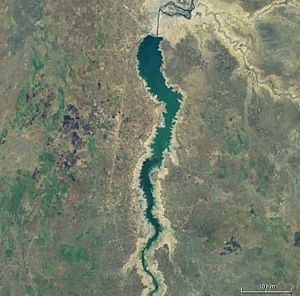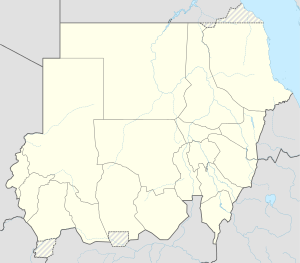Khashm-el-Girba dam
| Khashm el-Girba dam, Khashm al-Qirba dam |
|||||||||
|---|---|---|---|---|---|---|---|---|---|
|
|||||||||
|
|
|||||||||
| Coordinates | 14 ° 55 ′ 31 ″ N , 35 ° 54 ′ 19 ″ E | ||||||||
| Data on the structure | |||||||||
| Construction time: | 1960-1964 | ||||||||
| Height of the barrier structure : | 47 m | ||||||||
| Crown length: | 3 750 m | ||||||||
| Power plant output: | 10 MW | ||||||||
| Data on the reservoir | |||||||||
| Altitude (at congestion destination ) | 470 m | ||||||||
| Reservoir length | 50 km | ||||||||
| Reservoir width | 5 km | ||||||||
| Total storage space : | 1 300 000 000 m³ | ||||||||
The Khashm el-Girba Dam ( Arabic خشم القربة, DMG Ḫašm al-Qirba ) dams the Atbara in the state of al-Qadarif in Sudan .
Reservoir
The approximately 5 km wide reservoir formed by the Khashm el-Girba dam extends over a length of about 50 km in a north-south direction from the place Khashm el Girba to a few kilometers below the city of Showak not far from the border triangle Sudan - Ethiopia - Eritrea in the southeast of the Butana steppe. Its target is at an altitude of 470 m above sea level. d. M.
dam
The Kashm el-Girba dam consists of a 47 m high gravity dam with a crown length of around 450 m, 2 × 5 MW Kaplan turbines , 3 × 8 MW pumps and 15 gates. The dam is bordered on both sides by a 1,800 m and 1,500 m long dam .
The Kashm el-Girba dam was built between 1960 and 1964 in order to provide a new livelihood for the approximately 50,000 inhabitants from the area of Wadi Halfa, who had been driven out by the Aswan Dam and the rising tides of Lake Nasser , in the New Halfa project . It is therefore primarily used to irrigate this project (500,000 Feddan about 2100 km²). The dam wall therefore contains a large outlet structure with which most of the water is drained to the irrigation systems via a large canal. If the water level sinks below the level of the canal, the canal can be filled with pumps from the then deeper lake.
Hydrology
The dam dams the Atbara, which is also known as the “Black Nile” because of its high sediment load. The alluvial material quickly silts up the lake. In 1974, ten years after the first full stowage, the volume had already halved from 1.3 km³ to 0.66 km³. The irrigation of the New Halfa project therefore had to be reduced.
In order to reduce further sedimentation , the reservoir has been completely emptied once a year since 1970 via the bottom outlet of the dam. This takes place when the tide rises in order to flush out as much sediment as possible. The resulting large fish deaths seem to have hardly any influence on the fish population of the Atbara.
Nevertheless, the inadequate water supply for the New Halfa project and the sedimentation problem have led to the construction of two new dams above Showak ( Rumela Dam and Burdana Dam ).
Since the dam is primarily used for irrigation, hardly any water is released into the underwater river during the low water phase. As a result, the agricultural use on the lower reaches of the Atbara has changed significantly due to the lack of water.
See also
Individual evidence
- ↑ JV Sutcliffe & YP Parks: The Hydrology of the Nile ( Memento of November 24, 2010 in the Internet Archive ), IAHS Special Publication no.5, 1999. (PDF; 812 kB)
- ^ A b Jens Mödinger, Christoph Grass and Abdelrahman Saghayroon Elzein: Hydrology, Sedimentation and Reservoir Management of the Merowe Project ( Memento from February 28, 2014 in the Internet Archive ) In: Wasserwirtschaft 1-2, 2011, p. 17
- ↑ Khashm El Girba Hydro Power Station Rehabilitation (2002-04) on the website of Heavy Engineering Ltd.
- ^ Terje Tvedt: The Nile: An Annotated Bibliography . IBTauris, 2004, ISBN 978-1-86064-879-3 ( Google Books ).
- ^ Nile Basin Capacity Building Network: Assessment of the Current State of the Nile Basin Reservoir. Sedimentation Problems ( Memento from March 5, 2016 in the Internet Archive ) , 2005
- ^ Jeppe Kolding: Fishing, flushing an fish behavior - A case study from the seasonal Kashm el Girba reservoir in Sudan , 1995

